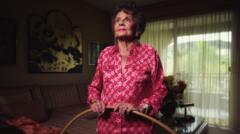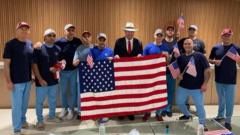Joan's journey from a model in Australia to the coiner of the hula hoop name marks a significant tale of creativity and perseverance. She is known for bringing the colorful hoop to life in the US, even though she received minimal recognition during her lifetime.
Joan Anderson, the Hula Hoop Pioneer, Passes Away at 101

Joan Anderson, the Hula Hoop Pioneer, Passes Away at 101
Joan Anderson, the unsung figure behind the popularization of the hula hoop, has died at the age of 101, leaving behind a legacy that shaped a global phenomenon.
Joan Anderson, renowned for her significant yet overlooked contribution to the hula hoop's popularity, has passed away at the impressive age of 101. Born as Joan Constance Manning in Sydney on December 28, 1923, Anderson was initially a swimsuit model. Her remarkable journey began when she encountered groups of people enjoying wooden hoops in Australia and was captivated enough to send one to the United States.
Her husband, Wayne Anderson, and she were instrumental in presenting the hula hoop idea to a toy company executive at Wham-O in the 1960s, securing a verbal agreement that marked the beginning of hula hoop fever in the American marketplace. However, despite the hoop's rapid success, the couple remained largely uncredited, leading them to eventually pursue legal action for recognition, resulting in a modest settlement but no acknowledgment of their innovative role in its inception.
Throughout the years, the narrative surrounding the hula hoop sometimes included vague references to an Australian "friend," which upset Anderson as she believed her story wasn't accurately represented. The hula hoop became a cultural icon, selling millions worldwide, yet Anderson and her contributions were largely overlooked until later accounts began to surface.
In response to the renewed interest in her story, a documentary titled "Hula Girl" focused on Anderson's fascinating life, giving her overdue recognition. She passed away on July 14 at a nursing home in Carlsbad, California, and is survived by her children and grandchildren. Her family's remarks highlight the amazing life she led, full of significant impact and creativity.
Her husband, Wayne Anderson, and she were instrumental in presenting the hula hoop idea to a toy company executive at Wham-O in the 1960s, securing a verbal agreement that marked the beginning of hula hoop fever in the American marketplace. However, despite the hoop's rapid success, the couple remained largely uncredited, leading them to eventually pursue legal action for recognition, resulting in a modest settlement but no acknowledgment of their innovative role in its inception.
Throughout the years, the narrative surrounding the hula hoop sometimes included vague references to an Australian "friend," which upset Anderson as she believed her story wasn't accurately represented. The hula hoop became a cultural icon, selling millions worldwide, yet Anderson and her contributions were largely overlooked until later accounts began to surface.
In response to the renewed interest in her story, a documentary titled "Hula Girl" focused on Anderson's fascinating life, giving her overdue recognition. She passed away on July 14 at a nursing home in Carlsbad, California, and is survived by her children and grandchildren. Her family's remarks highlight the amazing life she led, full of significant impact and creativity.




















